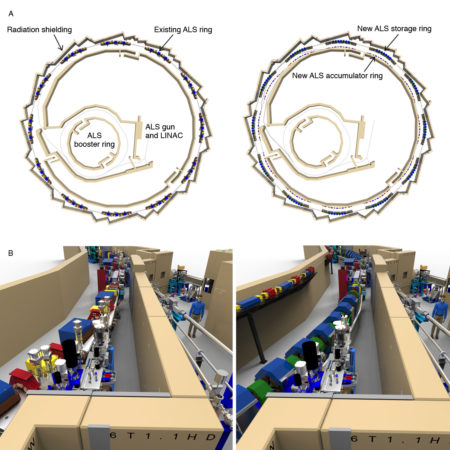by Dave Robin, on behalf of the ALS-U Project Development Team
 On Thursday, June 9, DOE’s Basic Energy Sciences Advisory Committee (BESAC) released the recommendations of the BES Facility Upgrade Prioritization Subcommittee. I’m pleased to announce that the subcommittee (whose full report can be found here) considers the proposed ALS-U project “absolutely central” to contribute to world leading science and “ready to initiate construction”—the highest possible ratings.
On Thursday, June 9, DOE’s Basic Energy Sciences Advisory Committee (BESAC) released the recommendations of the BES Facility Upgrade Prioritization Subcommittee. I’m pleased to announce that the subcommittee (whose full report can be found here) considers the proposed ALS-U project “absolutely central” to contribute to world leading science and “ready to initiate construction”—the highest possible ratings.
In a December 21, 2015 letter, Director of the DOE Office of Science (SC) Cherry Murray asked BESAC to provide an update of its assessment of the proposed upgrades to x-ray scattering facilities and to the Spallation Neutron Source using the same criteria that were used in prior studies—“the ability of a proposed upgrade or construction project to contribute to world leading science and the readiness of the upgrade or construction project to proceed to construction.”
The five proposed facility upgrade projects included in the assessment were: the Advanced Photon Source Upgrade (APS-U); the Advanced Light Source Upgrade (ALS-U); the Linac Coherent Light Source II High Energy Upgrade (LCLS-II-HE); the Proton Power Upgrade (PPU) at the Spallation Neutron Source; and the Second Target Station (STS) at the Spallation Neutron Source.
The report acknowledges that “the Office of Basic Energy Sciences’ (BES) x-ray and neutron user facilities play an ever increasingly critical role for fundamental discovery science and innovation,” and that, due to international investments in new facilities that will compete with US science and technology, “Without the planned upgrades the APS and the ALS will soon be relegated as second tier facilities.”

Under the ALS-U proposal, the existing ALS storage ring would be replaced with powerful new compact magnets arranged in a multibend achromat (MBA) lattice. This new lattice, in combination with other improvements to the electron accelerator, would reduce the electron beam emittance and dramatically increase the transverse x-ray coherence, producing up to 1000 times more soft x-ray coherent flux than today’s ALS—well beyond that of any ring-based light source in operation, under construction, or planned. The resulting stable, nearly continuous-wave, highly coherent, soft x-ray beams would enable important new types of scientific inquiry by allowing us to resolve nanometer-scale features and interactions, and follow real-time kinetics, revealing the nature of chemical transformations and the origin of the functional behavior of complex materials.
With regards to ALS-U, the report specifically highlighted the ability of an MBA lattice upgrade (now successfully demonstrated by MAX IV) to result in a truly coherent soft x-ray source that will allow the ALS to remain the world leading facility in this area of science for the foreseeable future. In addition, the subcommittee commented on the novel “swap-out” injection that will be employed by both APS-U and ALS-U and will enable a leap in performance over other international MBA designs.
The report also noted the “historically strong coupling between the experiments at the ALS and the computational and theoretical science community” and encouraged ALS management to “enhance their outreach efforts to engage the user community in the design and planning for the ALS-U project and the associated beam line upgrades.” Actively involving our user community in the project as it develops is critical, and we look forward to valuable input.
The outcome of the BESAC prioritization is the direct result of our expert staff and engaged user community. Through support from Berkeley Lab and more recently from BES, staff members in the Accelerator Technology and Applied Physics (ATAP), Engineering, and ALS Divisions have invested more than three years of R&D to develop the ALS-U concept. The ALS-U initiative has received tremendous support across the lab, and Berkeley Lab Director Mike Witherell has stated that ALS-U is the laboratory’s highest priority project. I could not imagine a stronger or more enthusiastic team. I’m hopeful that the subcommittee’s recommendation will bring us one step closer to a mission need approval (CD-0) for this proposed project and put us on the path towards upgrading the ALS, providing revolutionary light source capabilities to our user community and ensuring continued US leadership in soft x-ray science.